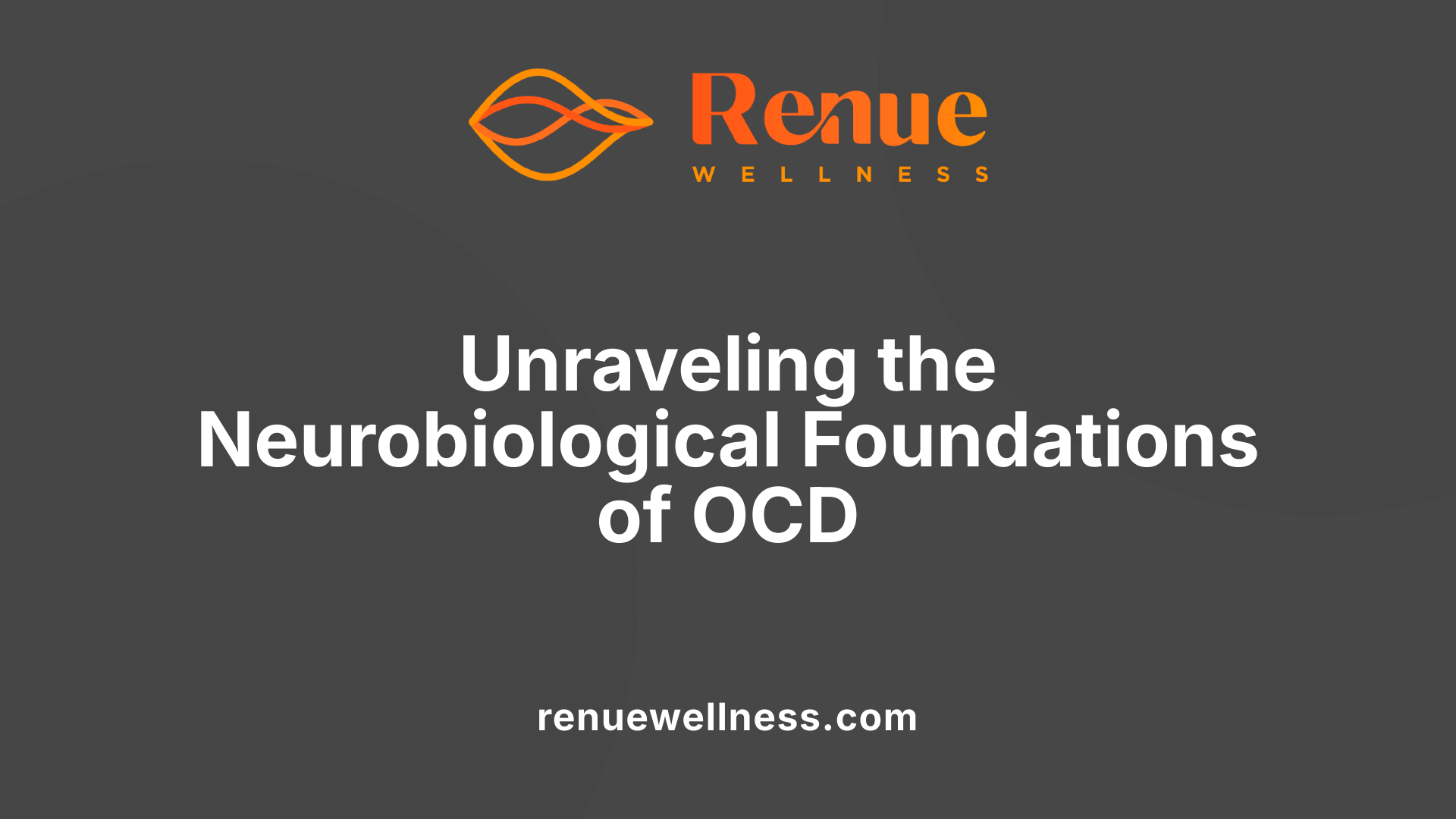Understanding the OCD Brain—and Where Ketamine Comes In


July 29, 2025
Understanding OCD and the Promise of Innovative Therapies
Obsessive-compulsive disorder (OCD) is a complex neuropsychiatric condition characterized by intrusive thoughts and compulsive behaviors, disrupting daily life and impairing functioning. Traditional treatments, including SSRIs and cognitive-behavioral therapy, provide relief for many but fall short for a significant subset of patients. Exciting advances in neurobiology and pharmacology have uncovered new avenues for intervention, notably the off-label use of ketamine, a drug known for its rapid antidepressant effects, now being explored as a potential treatment for resistant OCD.
Neurobiological Underpinnings of OCD

What is the neurobiology of OCD and how do specific brain regions and neural circuits involved in OCD contribute to the disorder?
Obsessive-Compulsive Disorder (OCD) has a complex neurobiological basis that involves specific brain regions and neural pathways. Key structures include parts of the cortico-striato-thalamo-cortical (CSTC) circuit, which plays a critical role in the development and persistence of OCD symptoms.
Within this circuit, the orbitofrontal cortex (OFC), anterior cingulate cortex (ACC), and the basal ganglia—particularly the caudate nucleus—are important. These areas are responsible for processing decision-making, inhibition, and forming habitual behaviors. Neuroimaging studies have shown that individuals with OCD often exhibit increased gray matter volume in the subcortical basal ganglia regions, such as the caudate, alongside decreased cortical thickness in the frontal regions, pointing to structural differences.
Functional abnormalities are also prominent. Patients tend to have hypoactivity and disrupted connectivity in the frontal cortex and related regions involved in cognitive control and inhibition. This decreased regulation may allow obsessive thoughts to persist and compulsive behaviors to become habitual.
Furthermore, the thalamus acts as a relay station, often showing altered activity, which may amplify signals related to compulsive urges. Wide-ranging studies also indicate abnormalities in limbic circuits, implicating emotional processing areas in OCD.
These neural changes support the idea that OCD involves dysregulated activity within interconnected brain circuits. The dysfunction leads to an overactive habit formation system and a failure to inhibit obsessive thoughts.
Interestingly, some neurobiological alterations tend to improve or normalize with effective treatments, including pharmacotherapy and behavioral therapy, underscoring the importance of these circuits in the disorder.
Understanding these brain structures and their connections helps guide targeted treatments like ketamine, which influences glutamate pathways within these circuits, potentially restoring balance and alleviating symptoms.
Ketamine's Impact on Brain Mechanisms in OCD

How does ketamine affect brain mechanisms involved in OCD, and what is the scientific rationale for using ketamine as a treatment?
Ketamine influences brain mechanisms linked to obsessive-compulsive disorder (OCD) chiefly through its interaction with NMDA receptors, a subtype of glutamate receptor in the brain. By acting as an antagonist of these receptors, ketamine effectively modulates glutamate transmission, which is a critical neurotransmitter involved in neural communication and plasticity.
One way ketamine exerts its effects is by increasing glutamate levels in specific brain regions, such as the prefrontal cortex. This increase stimulates AMPA receptors, leading to a cascade of neurochemical events that promote the formation of new synaptic connections. These processes involve pathways like mTOR and BDNF (brain-derived neurotrophic factor), which are crucial for neuroplasticity—the brain's ability to rewire itself.
Enhanced neuroplasticity helps in disrupting rigid neural circuits that sustain obsessive thoughts and compulsive behaviors. Studies show that after ketamine administration, there is an increase in synaptic density, which may facilitate the extinction of fear responses and reduce the pathological activity in circuits involving the orbitofrontal cortex, anterior cingulate cortex, and basal ganglia—areas known to be overactive in OCD.
Furthermore, ketamine appears to influence the balance of excitatory and inhibitory signals within these circuits, helping to restore normal functioning. It also promotes neuroplasticity which supports the ability of patients to engage more effectively with therapies such as exposure and response prevention.
Neuroimaging research provides evidence that ketamine temporarily reduces hyperactivity in OCD-related circuits, leading to more manageable symptoms. Neurochemical studies reinforce this by showing increased GABA (inhibitory neurotransmitter) levels, which help dampen excessive neural activity associated with compulsions.
The scientific rationale behind using ketamine for OCD is based on its capacity to rapidly induce neuroplastic changes, break maladaptive circuit patterns, and promote fear extinction. These effects can be particularly beneficial in treatment-resistant OCD cases, where traditional therapies like SSRIs and cognitive-behavioral therapy have limited success. Although the benefits tend to be short-term when used alone, ongoing research suggests that combining ketamine with psychotherapy could offer lasting improvements for individuals battling severe OCD.
Current Research and Clinical Trials on Ketamine for OCD

What are the current scientific insights and ongoing research regarding ketamine as a treatment for OCD?
Recent studies point to promising potential for ketamine in alleviating obsessive-compulsive disorder (OCD), especially for those resistant to traditional therapies. Clinical trials have shown that a single low-dose IV infusion of ketamine can produce rapid reductions in OCD symptoms, often within hours to a few days. These effects can last from several days up to a week, offering quick relief compared to standard treatments like SSRIs and CBT, which typically take weeks to take effect.
One notable trial involved 15 OCD patients receiving ketamine infusions at Columbia University in 2013. The researchers observed an immediate decrease in symptoms after treatment, with some patients experiencing effects lasting about a week. This supports the idea that ketamine acts on neural pathways related to OCD through its influence on the glutamate system. Specifically, ketamine blocks NMDA receptors, modulating glutamate transmission and promoting neuroplasticity, which may help reset hyperactive brain circuits involved in OCD.
In addition to direct clinical trials, research is exploring the neurochemical and neuroimaging mechanisms behind ketamine’s effects. Studies suggest it increases glutamate levels temporarily and affects brain areas like the prefrontal cortex and basal ganglia—regions involved in obsessive thoughts and compulsive behaviors. Furthermore, metabolites of ketamine, such as hydroxynorketamine, are being studied for their potential to provide antidepressant benefits without some of the side effects typically associated with ketamine, such as dissociation or abuse potential.
Ongoing large-scale studies, including those led by researchers at Stanford University, aim to assess how ketamine influences brain function over extended periods, typically over six months. These studies seek to determine not only short-term safety and efficacy but also long-term outcomes, optimal treatment protocols, and potential integration with psychotherapy.
While current findings are encouraging, broader research with diverse populations and standardized protocols is needed to establish definitive safety guidelines and determine lasting benefits. The proliferation of commercial ketamine clinics underscores the urgency for formal guidelines based on scientific evidence to ensure safe and effective use.
In summary, ketamine shows substantial promise as an innovative treatment for OCD, especially in treatment-resistant cases. Scientific insights continue to evolve, fueled by clinical trials and neurochemical research, moving toward safer, targeted, and more effective therapeutic strategies.
Neurochemical Changes During Ketamine Treatment

How does ketamine influence neurochemical changes associated with OCD and what are its effects during treatment?
Research indicates that ketamine impacts brain neurochemistry in individuals with OCD primarily through its modulation of glutamate levels and GABAergic activity. As an NMDA receptor antagonist, ketamine increases glutamate transmission, which in turn promotes neuroplasticity—the brain's ability to form new connections. This neuroplastic effect helps to reset abnormal neural circuits involved in OCD, particularly within the cortico-striato-thalamo-cortical (CSTC) loop.
During treatment, neuroimaging studies reveal that ketamine administration leads to significant changes in brain activity and chemistry. For example, proton magnetic resonance spectroscopy (1H MRS) measures have shown that GABA levels in the medial prefrontal cortex (MPFC) increase during ketamine infusions. This increase in GABA, an inhibitory neurotransmitter, correlates positively with reductions in OCD symptoms, highlighting the importance of balanced excitatory and inhibitory signaling in symptom relief.
Interestingly, glutamate levels (specifically Glutamate + Glutamine) do not show consistent changes in the MPFC during ketamine treatment, suggesting that the primary neurochemical effect may be through GABAergic pathways or other glutamate receptor interactions.
Neuroimaging findings also demonstrate that ketamine reduces hyperactivity in OCD-associated brain regions such as the OFC and ACC. This suggests that ketamine's ability to diminish overactive circuits contributes to its rapid symptom-relief effects.
Overall, ketamine fosters a neurochemical environment conducive to neuroplastic changes, which helps in breaking rigid obsessive-compulsive patterns. The combined effects on glutamate and GABA systems, along with alterations in brain network activity observed through neuroimaging, underscore its potential as a fast-acting treatment option for resistant OCD cases.
Traditional and Emerging OCD Treatments, including Ketamine

What treatment options are available for OCD, and how does ketamine compare to traditional therapies?
Conventional treatments for obsessive-compulsive disorder (OCD) mainly consist of cognitive-behavioral therapy (CBT), especially exposure and response prevention (ERP), and medications called selective serotonin reuptake inhibitors (SSRIs). These approaches usually take several weeks to months before noticeable improvements are observed. Despite their effectiveness, about 40% of patients find limited relief from these standard treatments, especially when the disorder becomes resistant.
Recently, ketamine has gained attention as an alternative treatment option, particularly for those who do not respond well to traditional therapies. Originally developed as an anesthetic, ketamine influences the brain's glutamate system by blocking NMDA receptors, which plays a critical role in neural communication and plasticity.
The main advantage of ketamine is its rapid onset. Unlike SSRIs or CBT, which can take weeks to show effects, ketamine can produce significant symptom reduction within hours or days. Clinical trials have shown that low doses of ketamine result in quick relief from obsessive thoughts and compulsive behaviors, sometimes lasting several days to weeks.
In terms of safety, ketamine is not free from concerns. There is potential for dependence, cognitive side effects, and bladder issues with prolonged use. Therefore, its administration is usually confined to clinical settings with professional supervision, and ongoing research is exploring the long-term safety profile.
Overall, ketamine offers a promising, faster-acting alternative or addition to existing OCD treatments. Its ability to promote neuroplasticity and reset abnormal neural circuits makes it especially appealing for treatment-resistant cases. However, more studies are essential to establish standardized protocols, determine long-term benefits, and ensure safety in the broader patient population.
Clinical Trials and Regulatory Status of Ketamine for OCD

Are there clinical trials available investigating the efficacy of ketamine in treating OCD?
Yes, multiple clinical trials have investigated ketamine’s potential to treat obsessive-compulsive disorder (OCD). A notable 2012 trial involved 15 patients and used IV infusions, observing rapid reductions in OCD symptoms lasting about a week and a half. Additionally, researchers like Dr. Carolyn Rodriguez at Stanford Medicine have conducted larger studies, including a five-year trial with 90 OCD patients, to assess long-term effects.
Numerous smaller studies, including randomized controlled trials and case reports, indicate that ketamine can produce immediate symptom relief, especially for those resistant to conventional treatments. For example, a 2013 trial at Columbia University with 15 participants showed brief but significant symptom reduction after infusion. Ongoing research continues to refine dosing protocols and understand the full scope of ketamine’s benefits.
While the results are promising, more comprehensive studies with larger populations and standardized protocols are necessary to conclusively confirm ketamine’s efficacy for OCD treatment.
The Future of OCD Neurotherapy
Research into ketamine for OCD is still evolving, but early clinical and neurochemical evidence indicates that it could revolutionize treatment strategies, especially for those with treatment-resistant forms of the disorder. As ongoing studies clarify long-term safety, optimal dosing, and mechanisms of action, ketamine may become an integral part of personalized neuropsychiatric interventions. Understanding the neurobiology of OCD has paved the way for targeted therapies that modulate neural circuits and neurochemical imbalances—pathways that ketamine influences profoundly. With continued scientific inquiry, the hope is that more effective, rapid, and safe treatments will soon be available for millions affected by this challenging disorder.
References
- The pros and cons of ketamine for obsessive compulsive disorder ...
- Ketamine for OCD: How Does it Work? - Conscious Health
- Ketamine Infusion in a Resistant Obsessive-Compulsive Disorder ...
- OCD and Ketamine | Wu Tsai Neurosciences Institute
- How Does Ketamine Help OCD? | Waybridge Health
- What to Expect During Your First Ketamine Infusion for OCD
- Ketamine Treatment for OCD Near Me: Protocols and Outcomes
- Ketamine as a Treatment for OCD: New Research & Key Insights
- Ketamine Therapy For OCD, Explained - Bespoke Treatment
- Ketamine Infusion Therapy & OCD - Catalyst Clinic in UT
Recent Posts
Conditions Treated
AnxietyDepressionOCDPTSDPostpartum DepressionPain ManagementSubstance AbuseSuicidal IdeationOur Location


